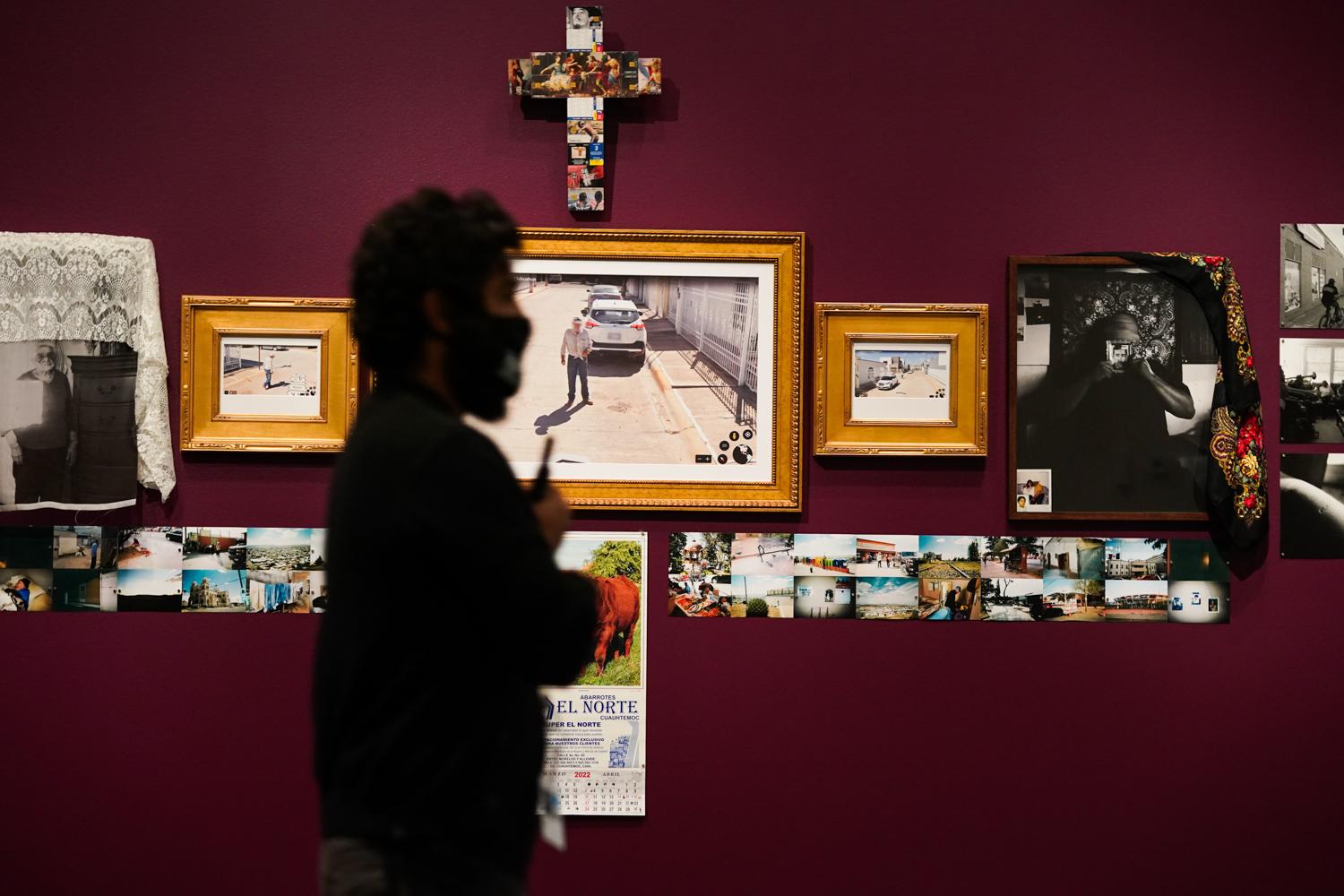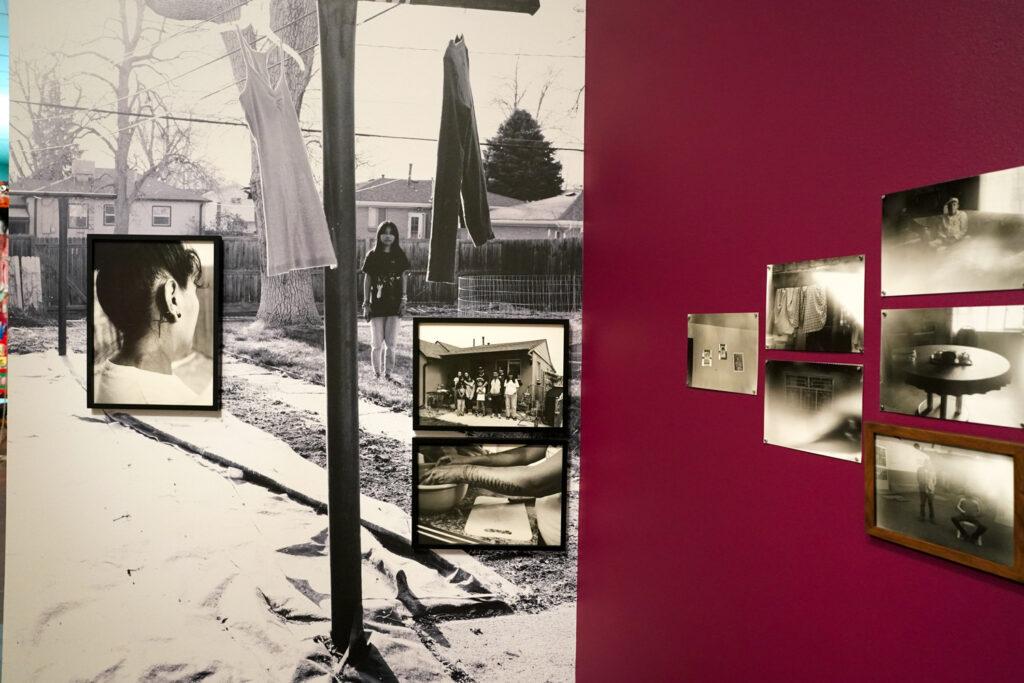
Standing in front of photographer Juan Fuentes’ installation at the Denver Art Museum feels like being in someone’s living room. A mantle covered in fabric displays family portraits. Ornate gold frames and an image printed on silk — framed by lace — add to the effect that you are standing in your grandmother’s home.
“To me, that’s comfort. That’s a safe space. Representation, and being able to see ourselves in these big institutions, is very important and is very intentional within my decision to tell this story,” Fuentes said.
The intimacy he creates with the exhibit space reflects what he has captured in the images and art pieces on the walls of the work, “On the Dirt, Our Knees Tell Truths,” and in Spanish, “En la Tierra, Nuestras Rodillas Dicen Verdades.” The name is borrowed from a poem by Salvadoran poet Javier Zamora. To Fuentes, the title is meant to represent the truths of people who work the land.
“The immigrant experience, for the most part, here in the United States also comes with very hard labor,” Fuentes said in an interview with CPR News.
Images by Fuentes, as well as ones he has curated from his brother and a friend, show moments in kitchens, backyards, and in places that make up a hometown — whether that’s in Denver or in Mexico. Fuentes was born in Chihuahua, Mexico, but has spent much of his life in Denver after immigrating as a 1-year-old.
Fuentes is not a well-known name in the art world – at least not yet. He’s a homegrown creator whose work is part of an exhibition of 19 Latin American artists called “Who Tells a Tale Adds a Tail,” which runs at the Denver Art Museum through March 5, 2023.

Locally, he is best known for an Instagram account he created, @olddenver, which captures how much the city is changing. For Fuentes, the DAM exhibition is an opportunity to get even more personal than in the Instagram account.
Fuentes spoke with Colorado Matters senior host Ryan Warner. This is an edited transcript of their conversation.
Ryan Warner: I understand that when you were little, you used disposable cameras to capture parts of your life.
Juan Fuentes: Yeah, it was mostly just on family vacations, for whatever reason, I ended up with the cameras in my hand. A lot of my memories that are still around come from disposable cameras. With this exhibition, I was definitely trying to tap into that feeling I used to get from getting a disposable camera back. So some of the images that you see unframed are actually from a disposable camera. This was a collaboration between my brother and me. I would send him the cameras in Chihuahua, Mexico. I told him to document as if we were back on our summer trips and taking the photographs of the things that we grew up with, like the big cathedral at the center of the city, and in my grandma's backyard — my uncle’s clothes are almost always hanging in the back.
Warner: What’s an image you made in this collection that’s particularly meaningful for you?
Fuentes: The first image that it starts with is a very meaningful one. It's outside of this bus station in Denver called Los Paisanos. This is a photograph that I took back in 2017 while people were boarding the last bus of the day, which is the late bus. It's meaningful to me because it's part of my memory; going back to Mexico as a kid was always hopping onto the late bus at Los Paisanos and getting to see so many families going back home to reconnect. It’s just a very special image that brings back a lot of memories – the smell of the bus, getting excited because I would create a CD mix for the ride back to my hometown, because usually it was about a 20 hour bus ride. So always getting excited to just be on the bus, get to see the scenery, listen to some new music. And then also the excitement of knowing that the following day, I'd be back home.
Warner: What story do you hope to tell, or experience do you hope to get across, with this show?
Fuentes: I hope that immigrants experiencing things similar to me can see themselves and find the little details that point at the fact that I am an immigrant. And that these are a lot of things that we've all used to reconnect to our place of birth, and a lot of us coming from Mexico. Outside of the photographs, I also created a cross made out of these Telcel or Telmex cards, which were long distance phone cards that I used to collect in Mexico. These are the items and the artifacts that we grew up on. So to me, the story I wanted to tell is my own personal one, but with the hopes that a lot of people can connect to it and see themselves within that.

Warner: Were you into art in general, beyond disposable cameras, when you were a kid?
Fuentes: Oh yeah, I was always drawing, painting, did graffiti, skateboarding, made music, ever since I was a kid. Skateboarding taught me so much – learning how to fail is very important in your practice in art, and skateboarding taught me a lot of that.
Warner: What’s the idea behind the old Denver Instagram account?
Fuentes: Originally it was to share photographs that resembled the things that I grew up with in Denver that I felt like were fading away due to gentrification. And it kind of grew into this community space where people were sharing their photos as well. To me, it feels like this digital archive that's kind of living and breathing, but also feels like a puzzle that had been scattered that is getting put back together.
Warner: What would you say to someone around the age you were when you were skateboarding and taking photos with a disposable camera – someone who has a flame of artistic talent and is wondering how to direct it?
Fuentes: Just to experiment and trust yourself. And don't be afraid to tell your story. I think it's important for artists to understand that art can be a place where we can give ourselves a voice and an opportunity to be authors of our own stories.

Other work by Fuentes is on display at the Anythink Library in Bennett, and at Re:Vision Co-op in Denver. In October, he will open an installation inside the Aurora Central Library.









